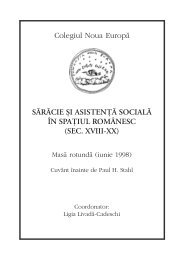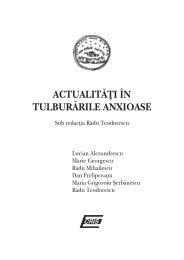New Europe College Regional Program Yearbook 2001-2002
New Europe College Regional Program Yearbook 2001-2002
New Europe College Regional Program Yearbook 2001-2002
You also want an ePaper? Increase the reach of your titles
YUMPU automatically turns print PDFs into web optimized ePapers that Google loves.
NIKOLAI VUKOV<br />
continuity in life.” 6 As R. Hertz observes, the notion of death is closely<br />
connected to that of rebirth and resurrection, and the exclusion of the<br />
dead from the community (always followed, however, by new integration),<br />
has at its roots the impulse of resurrecting and symbolically reinstalling<br />
the dead among the living (cf. Hertz 1960:79, Seale 1998:67; Mathieu<br />
1986). 7 Resurrective practices restore a sense of basic security fractured<br />
by death (Seale 1998:4), and by stretching over this rupture it fights death,<br />
symbolically overcomes it, providing “proof” of continuities which death<br />
has tried to destroy.<br />
The bones of the dead, as Hertz persuasively demonstrates, can become<br />
protective relics, representing benevolent ancestoral spirits, and can serve<br />
as a main source in defining and sustaining the idea of the sacred, as<br />
well as of the belief that relics ensure the material bridge between life<br />
and death. Most clearly expressed in Christian tradition, though wellknown<br />
to other religions and cultures, the belief that a “holy” body refers<br />
to a body which has overcome the corruptibility of the flesh, and that, by<br />
the relics it has left and the martyr’s or heroic narratives it has given rise<br />
to, it “stretches” towards resurrection, “strives” to take hold of time,<br />
overcomes time’s passing dominion. By their ability to fight the corruption<br />
of matter, dead bodies can turn into vis vegetans, vestigium vitae, and<br />
can serve as sources of life, as tools for transforming the pure negativity<br />
of death, as means of achieving fertility and hope. According to Hertz,<br />
the presence of the dead, duly honored, guarantees the prosperity of the<br />
living, and thus, by establishing a society of the dead the society of the<br />
living “regularly recreates itself”.<br />
As validity of the symbolic mechanisms underlying religion, traditional<br />
culture, and folklore, these features of the holy dead have not lost their<br />
special importance for the modern methods of ordering and perceiving<br />
the world. It is particularly interesting to see how this functioned in the<br />
general discourse of life and death in socialist Eastern <strong>Europe</strong>, where the<br />
bodies of communist heroes, as represented by socialist monuments –<br />
dying but uncorrupted, victims but heroic in overcoming defeat, killed<br />
but victorious – are turned into images personifying death and the<br />
regeneration of life. Monuments built after 1945 in Eastern <strong>Europe</strong> provide<br />
numerous examples of a particular interpretation of death through the<br />
notion of vitality. The enormity of death in the War was replicated, not<br />
so much in images of mourning, but in abundant expressions of victory<br />
and celebratory spirit. Moving representations of “overcoming” death<br />
and surviving the finality of life, images of fighters going beyond the<br />
259







